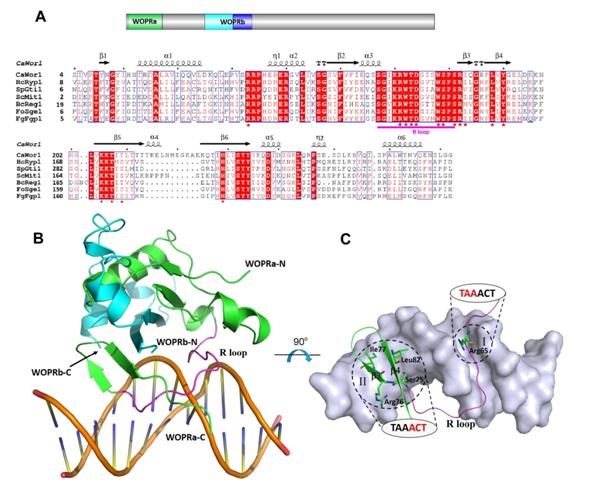
Crystal Structure of New DNA-binding Domain and Implications for Wor1 Function in White-opaque Switching of Candida albicans
Aug 17, 2014 Email"> PrintText Size

Candida albicans is the most frequently isolated opportunistic pathogen of humans. The Importantance of its pathogenesis is its ability to switch between different morphological forms, including a yeast-hyphae transition and white-opaque switching. Wor1 is a master regulator of the white-opaque switching in C. albicans, and is associated with its pathogenicity and commensality. Homologs of Wor1 have been found in every sequenced fungal genome. Besides C. albicans Wor1 (CaWor1), all the identified Wor1 homologs are also shown to play critical roles in regulation of key developmental processes. Wor1 contains a conserved DNA-binding region at the N-terminus consisting of two conserved segments (WOPRa and WOPRb) connected by a non-conserved linker that can bind to specific DNA sequences of the promoter regions and then regulates the transcription.
Under the supervision of Prof. CHEN Jiangye and Prof. DING Jianping from the Institute of Biochemistry and Cell Biology (SIBCB), Shanghai Institutes for Biological Sciences, PhD student ZHANG Shicheng and his colleagues solved the crystal structure of the C. albicans Wor1 WOPR box in complex with a double-stranded DNA (dsDNA) corresponding to a Wor1 binding sequence in the WOR1 promoter.
The sequentially separated WOPRa and WOPRb are structurally interwound together to form a compact globular domain that was termed the WOPR domain. The WOPR domain represents a new conserved fungal specific DNA-binding domain, which uses primarily a conserved loop to recognize and interact specifically with a conserved six-base motif of the DNA in both minor and major grooves. The structural and biological data together show that the WOPR domain of CaWor1 utilizes a combination of the base readout mechanism and the local shape readout mechanism to recognize and bind its specific DNA which have important implications for the function of CaWor1 in the activation of white-to-opaque switching.
This work entitled “Crystal structure of the WOPR-DNA complex and implications for Wor1 function in white-opaque switching of Candida albicans” was published online in Cell Research on the August 5, 2014.
This study was supported by grants from the National Natural Science Foundation of China, the Ministry of Science and Technology of China, and the Strategic Priority Research Program of the Chinese Academic of Sciences.

The WOPR domain represents a new conserved fungal specific DNA-binding domain (A) Sequence alignment of the WOPRa and WOPRb segments of Wor1 from different fungal species. (B) Crystal structure of the WOPR-DNA complex. (C) Recognition mechanism of the WOPR domain with its specific DNA. (Image by Prof. CHEN Jiangye`s group)
Candida albicans is the most frequently isolated opportunistic pathogen of humans. The Importantance of its pathogenesis is its ability to switch between different morphological forms, including a yeast-hyphae transition and white-opaque switching. Wor1 is a master regulator of the white-opaque switching in C. albicans, and is associated with its pathogenicity and commensality. Homologs of Wor1 have been found in every sequenced fungal genome. Besides C. albicans Wor1 (CaWor1), all the identified Wor1 homologs are also shown to play critical roles in regulation of key developmental processes. Wor1 contains a conserved DNA-binding region at the N-terminus consisting of two conserved segments (WOPRa and WOPRb) connected by a non-conserved linker that can bind to specific DNA sequences of the promoter regions and then regulates the transcription.
Under the supervision of Prof. CHEN Jiangye and Prof. DING Jianping from the Institute of Biochemistry and Cell Biology (SIBCB), Shanghai Institutes for Biological Sciences, PhD student ZHANG Shicheng and his colleagues solved the crystal structure of the C. albicans Wor1 WOPR box in complex with a double-stranded DNA (dsDNA) corresponding to a Wor1 binding sequence in the WOR1 promoter.
The sequentially separated WOPRa and WOPRb are structurally interwound together to form a compact globular domain that was termed the WOPR domain. The WOPR domain represents a new conserved fungal specific DNA-binding domain, which uses primarily a conserved loop to recognize and interact specifically with a conserved six-base motif of the DNA in both minor and major grooves. The structural and biological data together show that the WOPR domain of CaWor1 utilizes a combination of the base readout mechanism and the local shape readout mechanism to recognize and bind its specific DNA which have important implications for the function of CaWor1 in the activation of white-to-opaque switching.
This work entitled “Crystal structure of the WOPR-DNA complex and implications for Wor1 function in white-opaque switching of Candida albicans” was published online in Cell Research on the August 5, 2014.
This study was supported by grants from the National Natural Science Foundation of China, the Ministry of Science and Technology of China, and the Strategic Priority Research Program of the Chinese Academic of Sciences.

The WOPR domain represents a new conserved fungal specific DNA-binding domain (A) Sequence alignment of the WOPRa and WOPRb segments of Wor1 from different fungal species. (B) Crystal structure of the WOPR-DNA complex. (C) Recognition mechanism of the WOPR domain with its specific DNA. (Image by Prof. CHEN Jiangye`s group)
CAS Institutes
There are 124 Institutions directly under the CAS by the end of 2012, with 104 research institutes, five universities & supporting organizations, 12 management organizations that consist of the headquarters and branches, and three other units. Moreover, there are 25 legal entities affiliated and 22 CAS invested holding enterprisesThere are 124 I...>> more
Contact Us

Chinese Academy of Sciences
Add: 52 Sanlihe Rd., Xicheng District, Beijing, China
Postcode: 100864
Tel: 86-10-68597592 (day) 86-10-68597289 (night)
Fax: 86-10-68511095 (day) 86-10-68512458 (night)
E-mail: cas_en@cas.cn

